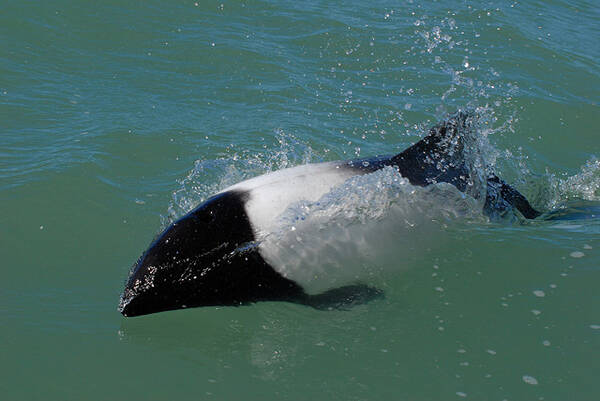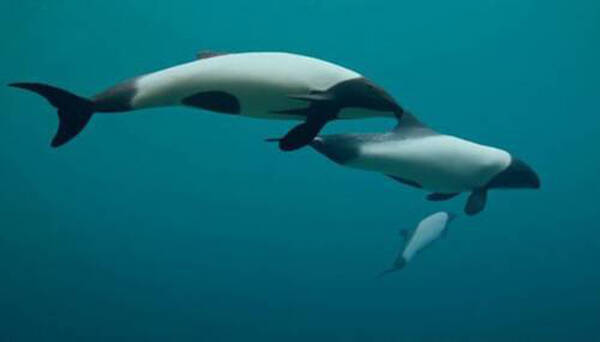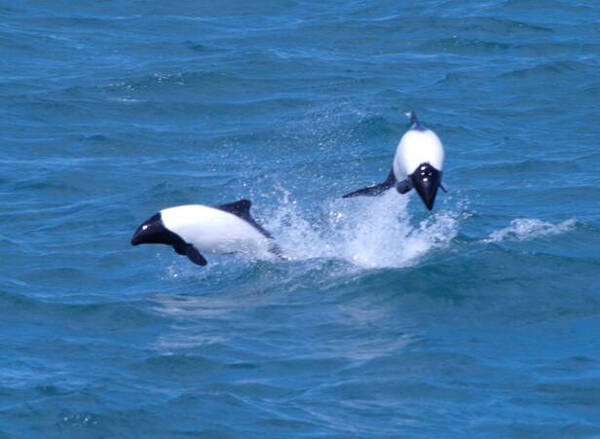Cephalorhynchus commersonii
IUCN
LCBasic Information
Scientific classification
- name:Cephalorhynchus commersonii
- Scientific Name:Black and white dolphin, panda dolphin, Connor's dwarf dolphin
- Outline:Cetacea
- Family:Delphinidae D.dolphin
Vital signs
- length:1.2-1.5m
- Weight:35-65kg
- lifetime:10-25years
Feature
The beak is quite sharp, with unclear boundaries between it and the forehead, and the pattern on its body is very similar to that of a panda.
Distribution and Habitat
The two subspecies of the spotted beaked dolphin are separated by the 130° meridian and are about 8,500 kilometers apart.
Origin (sea area): Argentina, Chile, Falkland Islands (Malvinas Islands), French Kerguelen Islands.
Roaming area (sea area): Brazil, South Africa.
Prefer shallow marine environments and live in ports, bays and estuaries along the coastline, where the water temperature is usually cold and shallow, ranging from 1 to 16°C. Most sightings occur in places with large tidal changes such as coastal harbors and wide and shallow continental shelves, while those far from the coast and in waters deeper than 200 meters are difficult to find. They swim to the coast with the tide, and some individuals even move in turbulent waters with currents greater than 15 km/h. Like their counterparts in the Strait of Magellan, they often appear in narrow waterways and near seaweed beds. It is believed that most spotted beaked dolphins stay away from the coast seasonally, no differen
Appearance
The head is black and conical. The beak is quite sharp and not clearly demarcated from the forehead. There is a white patch on the throat. The pectoral fins are rounded and black on both sides, with a serrated protrusion on the leading edge of the left pectoral fin (varies from individual to individual). The dorsal fin is located slightly behind the body in the middle of the back. The leading edge of the dorsal fin may be long and flat, and most dorsal fins have a slightly concave trailing edge. The end of the dorsal fin is not so rounded in some individuals. There is a black area connecting the dorsal fin to the caudal fin. The trunk is mainly white, with a black patch on the abdomen (the shape varies with sex); the caudal peduncle is black and has a very clear demarcation from the white area of the trunk. The caudal fin is black and slightly rounded at the end; the trailing edge of the caudal fin is concave inward (varies from individual to individual); the central notch of the cau
Details
The spotted beaked dolphin is the common name of Commerson's dolphin (scientific name: Cephalorhynchus commersonii), also known as Commerson's dolphin in English, and has two subspecies.

Spotted beaked dolphins usually live in groups of 1 to 3, and there are also large groups of more than 100 when they socialize. The size of the group is controlled by the dominant male dolphin, and those males who are not very aggressive can only commit to neighboring groups.
Spotted beaked dolphins sometimes forage alone near the border of the ocean current, but more commonly they hunt in groups. There are two main methods of hunting: the first is that 15 or fewer dolphins form a semicircle to drive the fish to the coast. Of course, some dolphins will temporarily run aground on the beach, but the stranded ones can return to the sea on their own; the other hunting group does not use the coast as a barrier, usually consisting of 2 to 6 groups to surround the fish school, and the group members take turns to cross the center of the encirclement to hunt, and then return to the circle.

In South America, spotted beaked dolphins have been observed swimming in the water with many birds and other marine mammals around them. Like other dolphins, they are often accompanied by flocks of seabirds (usually terns) hovering overhead. People like to associate them with Peet's spotted dolphins, such as long-term group swimming, similar hunting areas, riding the same big waves, and of course, they often interact with South Sea lions.

The breeding season of the spotted beaked dolphin is in September and February of the following year. After a gestation period of up to 12 months, the female chooses to give birth in winter. When the cub is born, its tail is ahead of its head, so that it can swim after leaving the mother. The calf is 0.5-0.75 meters long and weighs 4.5-7.3 kilograms. The dorsal and caudal fins are soft and smooth, and gradually harden with age. The care period of wild spotted beaked dolphins is unknown. In captivity, the calf begins to eat solid food 2 months after birth and eats whole live fish 4 months later. Males generally reach sexual maturity at the age of 6-9 years old, and females at the age of 5-9 years old. Individuals in the South Atlantic reach sexual maturity at a younger age than those in the Kerguelen Islands. The mother dolphin nurses the calf for about 9 months, during which time she keeps an eye on their activities. The calf also stays close to the mother dolphin and learns to swim along the mother's slipstream. If other females pass by and try to adopt the calf, the mother dolphin will come to protect it in time. The life span of wild spotted beaked dolphins does not exceed 10 years, and they usually live to 18 years in captivity. A spotted beaked dolphin at SeaWorld San Diego lived for 25.8 years.
If actual impacts are not taken into account, the spotted beaked dolphin may be the most abundant species in the genus. An aerial survey in 1988 in the northern Strait of Magellan estimated that at least 3,221 spotted beaked dolphins lived in the area. In the eastern Strait of Magellan, Venegas estimated in 1996 that the population size in the area was only 718 based on population density data recorded in the early summer of 1989 and 1990, which may be affected by calculation methods and date factors. In 2000, Lev Kuvot estimated the population size of the same area at 1,206 based on data from the summer of 1996. A survey in 2008 showed that there were about 21,000 spotted beaked dolphins along the entire South American coast, of which 7,000 were between 42 and 48 degrees south latitude and the remaining 14,000 were in the waters of Tierra del Fuego.
The South American population is listed in Appendix II of the Convention on the Conservation of Migratory Species of Wild Animals (CMS).
Listed in Appendix II of the Convention on International Trade in Endangered Species of Wild Fauna and Flora (CITES).
Listed in China's "National Key Protected Wildlife List": National Class II Protected Animals (effective December 10, 1988, Cetacean*Other Cetaceans).
Listed in the "IUCN Red List of Threatened Species": Data Deficient (DD), assessed in 2008.
Protect wild animals and stop eating game.
Maintaining ecological balance is everyone's responsibility!








